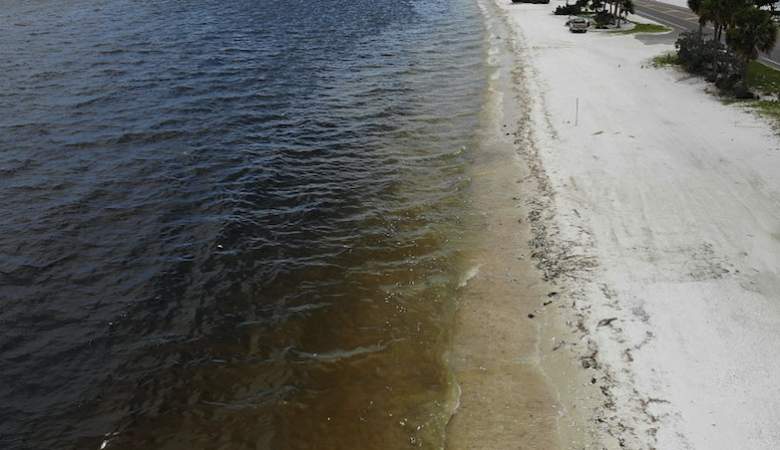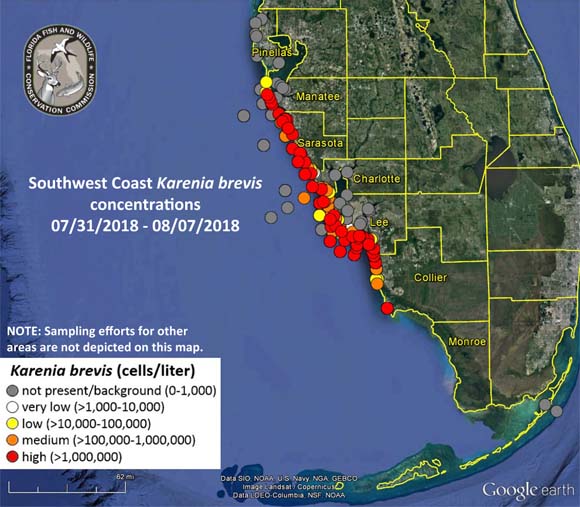
Getty The red tide status as of August 15 reflects the tide creeping southward down the southwestern side of Florida.
Red tide continues to be a massive presence along the beaches of Southwest Florida; as of August 13, Governor Rick Scott has declared a state of emergency for seven countiess along the southwest coast of Florida.
The counties include:
- Collier
- Lee
- Charlotte
- Sarasota
- Manatee
- Hillsborough
- Pinellas
A high concentration of red tide can lead to eye, nose, and throat irritation, as well as significant respiratory problems if you’re breathing in the air for too long.
Brad Dalton, deputy press secretary in the Office of Communications at the Florida Department of Health, told USA Today, “If you have symptoms, leave the beach and seek air conditioning,” he says. “If symptoms persist, please seek medical attention. People with severe or chronic respiratory conditions such as asthma or chronic lung disease are cautioned to avoid areas with active red tides.”
The Florida Fish & Wildlife Commission publishes updates on the status of red tide in Florida every Wednesday and Friday.
Beaches Under Red Tide Warning In Southwest Florida, as of August 15
For a full beach condition report, you can check out the interactive map from Mote Marine Beach Conditions Report. But here are a list of beaches currently deemed to be affected by the red tide, as of August 10, listed from the northernmost beach to the southernmost:
- Manatee Beach: “some” red drift in the water, “some” dead fish
- Coquina Beach: no red drift, “some” dead fish
- Lido Key: no red drift, “some” dead fish
- Siesta Key: “some” red drift, on both the beach and in the water, “some” with dead fish
- Nokomis: “some” red drift, on both the beach and in the water, “some” dead fish
- Venice North Jetty: “some” red drift, on both the beach and in the water, “some” dead fish
- Venice Beach: “thick” red drift in the water, “heavy” dead fish
- Manasota Beach: “some” red drift, on both the beach and in the water, “heavy” dead fish
- GI Range Light: “some” red drift, on both the beach and in the water, “heavy” dead fish
- GI State Park: “some” red drift, on both the beach and in the water, “some” dead fish
- Bowmans Beach: “some” red drift, no dead fish
- Light House Beach Sanibel Islands: “some” red drift, on both the beach and in the water, “some” dead fish
- Causeway Islands: no red drift in the water, “some” dead fish
- Lynn Hall Beach Park: “some” red drift on the beach, no dead fish
- Newton Park: “some” red drift on the beach, no dead fish
- Lovers Key State Park: “some” red drift in the water, “some” dead fish
- Bonita Beach: “some” red drift, “some” dead fish
- Vanderbilt Beach: “some” red drift on the beach and in the water, no dead fish
- Seagate Beach: “some” red drift on the beach and in the water, no dead fish
Areas Under a Red Tide Respiratory Warning In the Last Week
Per the Florida Fish & Wildlife Conservation Commission, here is a full list of areas that have been reported to be under a warning for respiratory irritation due to red tide in the last week:
- Manatee County
- Sarasota County
- Lee County
- Collier County
General Midweek Report of Red Tide in Southwest Florida, as of August 10

Red tide status as of August 8.
The current status of red tide has grown increasingly severe, and is creeping southward down Florida’s southwest coast, per the latest update by the Florida Fish & Wildlife Conservation Commission. The red tide is now suspected in the death of nine dolphins, as well.
NOAA reports that there is currently a “Gulf of Mexico Harmful Algal Forecast” in effect for all coastal communities in southwest Florida. The Forecast reads,
“In the Gulf of Mexico, HABs (or red tide) are caused by the rapid growth of a microscopic algae species called Karenia brevis. Red tide can impact the health of humans and animal life.NOAA provides forecasts that enable coastal communities as they respond to red tide. NOAA monitors conditions year around and provides official forecasts for red tide through two main products: the Conditions Reports and the Bulletins.The Conditions Report – Want to plan the perfect visit to the Gulf Coast? Pay attention to NOAA’s Conditions Report and find a coastal area unaffected by red tide.Red tide can cause respiratory and eye irritation in humans. The impacts vary by location and throughout the day. The Conditions Report identifies if red tide cell concentrations are present and provides forecasts of the highest potential level of respiratory irritation over the next 3-4 days. The website is updated twice a week during a red tide bloom, and additional updates are made if conditions change.”